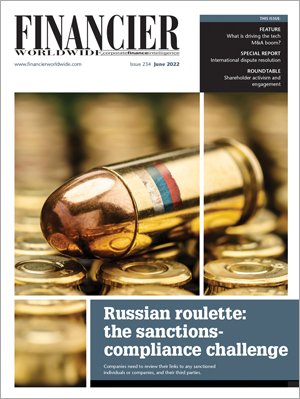Exiting the grey list: strengthening AML posture in the UAE
June 2022 | FEATURE | FRAUD & CORRUPTION
Financier Worldwide Magazine
Financial fair play is not a virtue one readily associates with the United Arab Emirates (UAE). On the contrary, the country was recently labelled a “money laundering paradise” by Transparency International – a regular target for malfeasant entities looking to legitimise their black money.
The UAE is particularly vulnerable to money laundering, as well as terrorist financing, due to its nature as a global and regional hub for trade and finance, large expatriate population and active gold and precious stone markets. This influx of big money makes the country, in particular the city of Dubai, increasingly susceptible to financial crime.
According to a 2020 report by the Carnegie Endowment for International Peace, the UAE is a “major money-laundering jurisdiction”, wherein illicit transactions are “a feature, not a bug” of Dubai’s financial system. The UAE also ranks poorly on the Basel Institute on Governance’s index of countries that are particularly vulnerable to money laundering and terrorist financing.
Such criticism led to an April 2020 assessment by the Financial Action Task Force (FATF) in which the watchdog warned the UAE to improve its anti-money laundering (AML) and counter-terrorism financing (CFT) posture, or risk being placed on the FATF ‘grey list’ (an official list of countries and jurisdictions that are identified as having strategic deficiencies in their regimes to counter money laundering, terrorist financing and proliferation financing) – a threat that came to pass in March 2022.
“Both in preparation for the 2020 assessment and in the intervening year and a half, the UAE took a flurry of actions to improve its compliance with international standards on AML and CFT,” says Katherine Bauer, a Blumstein-Katz Family fellow at the Washington Institute for Near East Policy. “Prior to the FATF assessment, the UAE conducted its own national risk assessment, addressed technical deficiencies in law and began implementing new regulatory regimes.
“However, the FATF determined that the UAE’s risk assessment did not adequately address the interplay between threats and vulnerabilities and noted that it was not yet clear if steps taken to mitigate risks were sufficient,” she continues. “For example, assessors reported that the UAE did not require suspicious activity reporting on real estate, a notably high-risk sector for money laundering in the UAE.”
“The UAE has stated its commitment to upholding the integrity of the international financial system. This pledge may help it to exit the ‘grey list’ in just a few years.”
In the view of Matthew Redhead, an associate fellow at the Royal United Services Institute (RUSI), while the UAE has sought to demonstrate that its anti-financial crime regime has some “teeth”, its actions to this end reflect the major underlying criticisms in the April 2020 FATF assessment that, although most of the right laws and institutions were in place, the UAE had not yet demonstrated their effective application.
Steps taken
Since the FATF warning in 2020, the UAE government has taken numerous steps to better align with global standards on AML and CFT, including setting up specialised courts to handle financial crimes and establishing a beneficial ownership registry. These steps have been praised by the International Monetary Fund (IMF).
“The UAE has shown high-tempo activity over the last year,” observes Mr Redhead. “In January 2021, the UAE federal government created an Executive Office for Anti-Money Laundering and Counter Terrorism Financing to oversee the national AML plan, while the Central Bank issued fines amounting to AED45.76m to 11 non-AML/CTF compliant banks. Also, in June 2021, the Central Bank of the UAE issued detailed guidance to the regulated private sector, while in August 2021, Dubai created a dedicated AML court.”
However, while the FATF’s 2022 grey-listing statement noted that the UAE had addressed many of the key recommendations made in the 2020 FATF assessment, many outstanding items remain, including a need to focus on improvements in effectiveness or demonstrating capacity – all of which cannot be achieved overnight.
“In the end, the FATF and many global commercial and financial actors, along with Emirati officials, want to see that the UAE is no longer considered a safe haven for illicit funds,” adds Ms Bauer. “To do this, the UAE will need to continue to ramp up international cooperation to go after illicit actors and their assets and close the regulatory gaps they exploit.”
Timetable for exit
With the resources and will to demonstrate better AML and CFT outcomes, the UAE has stated its commitment to upholding the integrity of the international financial system. This pledge may help it to exit the ‘grey list’ in just a few years.
“The FATF calls on grey-listed countries to make a ‘high-level political commitment’ to addressing identified deficiencies, and I think the UAE has demonstrated this in practice,” suggests Ms Bauer. “The challenge now is sustaining attention, resourcing and the pace of work to both exit FATF increased monitoring and build on recent gains more broadly.
“In the wake of the grey-listing, the UAE is already facing increased scrutiny due to concerns about Russian oligarch assets in and flowing to the Emirates since the Russian invasion of Ukraine and subsequent multilateral sanctions,” she concludes. “The eventual success or collapse of negotiations to revive the 2015 Iran nuclear deal will also likely bring renewed focus on Iranian financial and commercial activities in the UAE. It is possible these events will make the already difficult task ahead even harder.”
© Financier Worldwide
BY
Fraser Tennant


